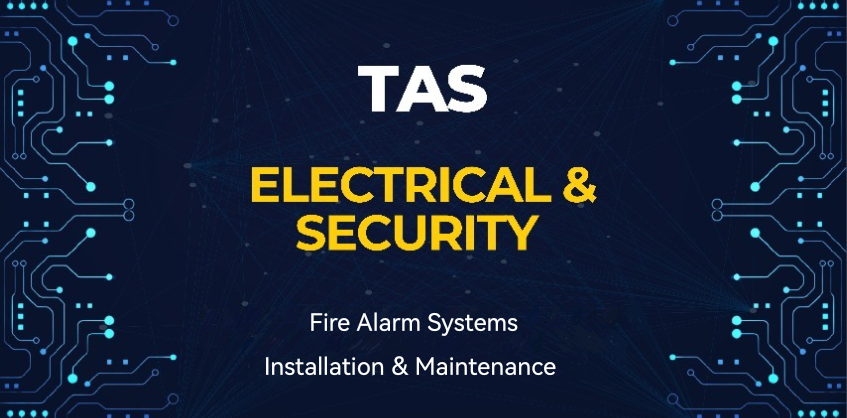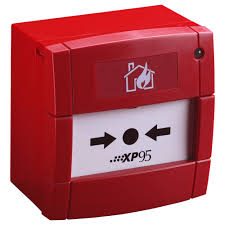| 07830655771 |  |
 |
 |
| Electricians Pinxton |
Fire Alarm Systems | CCTV Company |
Intruder Alarms |
Access Control |
Emergency Lighting | Nurse Call Systems | PAT Testing |
Security Lighting |
EICR Reports |
Fire Risk Assessments |
 |
With over a decade of NICEIC registration, TAS Electrical and Security is a trusted authority in the field. Specializing in early warning and life safety fire alarm systems, we offer comprehensive services including installation, testing, and maintenance. Our expertise spans all types of systems, ensuring top-notch protection for diverse settings. Trust TAS Electrical and Security for reliable solutions tailored to your fire safety needs. |
 |
At TAS Electrical, we prioritize seamless installation, testing, and maintenance of fire alarm systems with minimal disruption to working conditions and property. Our team is dedicated to ensuring efficient procedures that safeguard both productivity and the integrity of your premises. With meticulous planning and execution, we strive to complete projects swiftly and smoothly, allowing you to focus on your operations without interruption. Trust TAS Electrical for expert fire alarm solutions that prioritize safety and convenience for your environment. |
|
Fire safety is a paramount concern for landlords and business owners. Effective fire alarm systems are not only crucial for safeguarding lives and property but also for ensuring compliance with legal standards. In England, adhering to British Standards and relevant guidance notes is essential to fulfill fire safety obligations. Legal Obligations and British Standards The Regulatory Reform (Fire Safety) Order 2005: This order mandates that responsible persons (landlords and business owners) must ensure the safety of occupants by implementing adequate fire precautions, including fire detection and alarm systems. British Standard BS 5839-1:2017: This standard provides recommendations for the planning, design, installation, commissioning, and maintenance of fire detection and fire alarm systems in non-domestic premises. Adherence to BS 5839-1:2017 ensures that systems are reliable and effective in detecting fires early. British Standard BS 5839-6:2019: For domestic premises, including rental properties, this standard outlines the necessary fire detection and alarm systems. It specifies grades and categories of systems suitable for various property types, ensuring appropriate levels of protection. Housing Act 2004 and the Smoke and Carbon Monoxide Alarm (England) Regulations 2015: These regulations require landlords to install smoke alarms on every storey of their rental properties and carbon monoxide alarms in rooms with solid fuel appliances. They must ensure these alarms are functional at the start of each new tenancy. Importance of Fire Alarm Systems Property Protection: Effective fire alarms can help prevent extensive property damage by alerting occupants and emergency services early, facilitating a quicker response to control and extinguish the fire. Legal Compliance: Non-compliance with fire safety regulations can result in significant fines, legal action, and reputational damage. Ensuring your fire alarm systems meet British Standards and legal requirements helps avoid these risks. Insurance Requirements: Many insurance policies mandate the installation of compliant fire alarm systems. Failure to adhere to these requirements can result in higher premiums or even void insurance coverage in the event of a fire. Implementing Fire Alarm Systems with Minimal Disruption Detailed Planning: We work closely with landlords and business owners to schedule installations and maintenance at times that cause the least disruption to tenants and business operations. Efficient Execution: Our experienced technicians are trained to perform their tasks swiftly and efficiently, ensuring minimal interference with your daily activities. Regular Maintenance: To ensure ongoing compliance and functionality, we provide scheduled maintenance services that are planned around your convenience, keeping your fire alarm systems in optimal condition without affecting your operations. Relevant Guidance Notes Conclusion Fire Alarm Installers, Fire Alarm Installation, Fire Alarm Testing, Fire Alarm Maintenance Pinxton |
Fire Alarm Installers, Fire Alarm Installation, Fire Alarm Testing, Fire Alarm Maintenance Pinxton |
|
Fire safety is a critical aspect of property management, whether for residential, commercial, or industrial buildings. Installing the right fire alarm system is essential to protect lives, ensure property safety, and comply with legal regulations. In the UK, fire alarm systems are categorized into different grades based on their design, functionality, and application. This blog delves into the various types of fire alarm systems, their grades, and the relevant laws and British Standards that govern their use. Fire Alarm System Categories and Grades Types of Fire Alarm Systems Functionality: Conventional systems divide the premises into zones. When a detector or call point is activated, the control panel identifies the zone in which the fire has occurred. Functionality: Each device (detector or call point) has a unique address. The control panel identifies the exact location of the fire, enabling a quicker and more precise response. Functionality: These systems use radio signals to communicate between devices and the control panel, eliminating the need for wiring. Functionality: Combine both wired and wireless technologies, offering flexibility in installation and expansion. Grade A Systems: Components: Consist of a central control panel, detectors, sounders, and manual call points. They are similar to those used in commercial systems. Components: Less complex than Grade A, these systems still include detectors and sounders but with fewer requirements. Components: Mains-powered interlinked detectors and sounders with a backup power supply. LD1 (Life Protection 1): The Regulatory Reform (Fire Safety) Order 2005: Requirements: Mandates that responsible persons (landlords, business owners) ensure fire safety by implementing appropriate fire detection and alarm systems. Scope: Provides recommendations for the planning, design, installation, commissioning, and maintenance of fire detection and fire alarm systems in non-domestic premises. Scope: Covers fire detection and fire alarm systems in domestic premises, specifying the design, installation, and maintenance of such systems. Requirements: Mandate the installation of smoke alarms on every storey of a rental property and carbon monoxide alarms in rooms with solid fuel appliances. Landlords must ensure alarms are functional at the start of each new tenancy. At TAS Electrical and Security, we are dedicated to providing expert advice and high-quality fire alarm systems tailored to meet your specific needs. Contact us today to learn more about our services and how we can help you safeguard your property and its occupants.
Fire Alarm Installers, Fire Alarm Installation, Fire Alarm Testing, Fire Alarm Maintenance Pinxton
|
Fire Alarm Installers, Fire Alarm Installation, Fire Alarm Testing, Fire Alarm Maintenance Pinxton |
Fire Alarm Systems In Houses Of Multiple Occupation (HMOs) in The UK |
Fire safety in Houses of Multiple Occupation (HMOs) is a critical concern due to the higher risk associated with multiple occupants sharing the same building. Proper fire alarm systems are essential to ensure the safety of all residents and to comply with UK laws and standards. This blog provides an overview of the importance of fire alarm systems in HMOs, relevant laws, British Standards, and guidance notes. Importance of Fire Alarm Systems in HMOs Early Detection: Fire alarms provide early detection of smoke and fire, allowing occupants to evacuate quickly and safely. Avoiding Penalties: Compliance with fire safety regulations is mandatory for HMO landlords. Failure to comply can result in significant fines and legal action. Application: This legislation applies to all non-domestic premises and the common parts of HMOs. It requires responsible persons to conduct fire risk assessments and implement adequate fire safety measures. Overview: This act provides the legal framework for HMO regulations, including fire safety measures. It mandates that HMOs meet specific safety standards to be considered fit for habitation. Scope: This British Standard specifies the design, installation, and maintenance of fire detection and alarm systems in domestic premises, including HMOs. Guidance Notes: The Local Authorities Coordinators of Regulatory Services (LACORS) guide provides detailed recommendations for fire safety in residential properties, including HMOs. It emphasizes the importance of appropriate fire alarm systems and regular maintenance. Compliance Assurance: Professional installation ensures that fire alarm systems meet all relevant standards and legal requirements. Routine Checks: Regular testing and maintenance are crucial to ensure fire alarms are always operational. Fire Safety Awareness: Educating tenants on fire safety practices, including how to respond to alarms, can enhance overall safety. At TAS Electrical and Security, we offer expert fire alarm system services tailored to HMOs, ensuring compliance and safety. Contact us today to learn more about how we can help protect your property and tenants. |
Fire Alarm Installers, Fire Alarm Installation, Fire Alarm Testing, Fire Alarm Maintenance Pinxton |
|
Conduct a Fire Risk Assessment Identify Risks: Assess fire risks in your property, considering factors like building layout, usage, and high-risk areas (e.g., kitchens in homes or storage areas in businesses). BS 5839-6:2019: Determine the appropriate grade for residential properties. LD2 systems are often recommended for rental properties due to balanced coverage. Small Homes and Flats: Grade D LD3 systems may suffice, providing basic protection in escape routes. Expert Guidance: Consult fire safety professionals to assess specific needs and recommend the most suitable fire alarm system. Monthly Checks: Test fire alarm systems monthly to ensure functionality, including battery checks and ensuring all components work correctly. Clean Detectors: Regularly clean smoke detectors to prevent false alarms and maintain sensitivity. Stay Current: Upgrading to the latest fire alarm systems can enhance safety features and ensure compliance with newer standards. At TAS Electrical and Security, we specialize in providing tailored fire alarm solutions that meet the specific needs of your property. Contact us today to learn more about our services and how we can help you ensure optimal fire safety. Fire Alarm Installers, Fire Alarm Installation, Fire Alarm Testing, Fire Alarm Maintenance Pinxton |
Fire Alarm Installers, Fire Alarm Installation, Fire Alarm Testing, Fire Alarm Maintenance Pinxton |
Social Media |
Fire Alarm Installers, Fire Alarm Installation, Fire Alarm Testing, Fire Alarm Maintenance Pinxton |
 |
| 07830655771 |  |
Fire Alarm Installers, Fire Alarm Installation, Fire Alarm Testing, Fire Alarm Maintenance Pinxton |